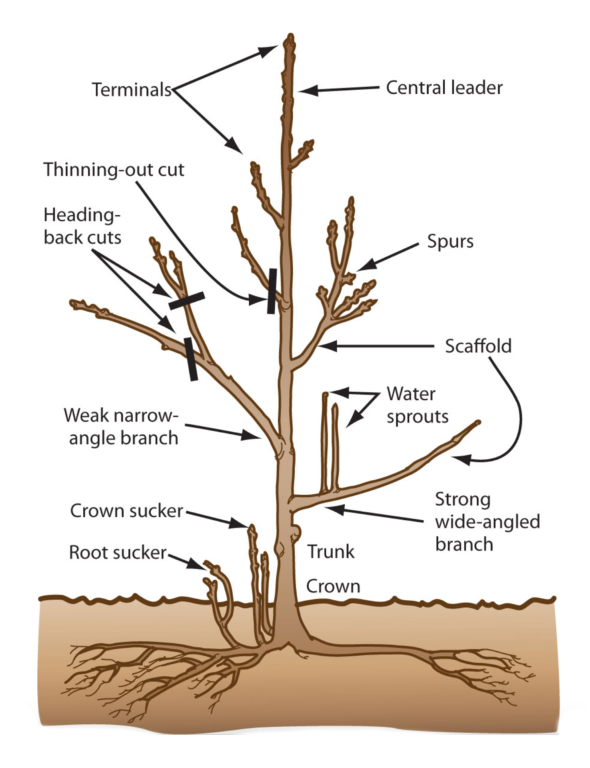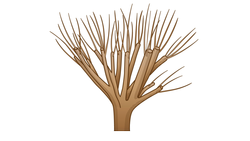Pruning Glossary

Back Bud
A dormant bud on bare branches below their leafy ends, or on the trunk. Depending upon the plant, pruning the leafy portions of branches can activate these back buds below each cut.
Bareroot
A plant with little or no soil on its roots. Bareroot plants are distinguished from plants in containers. Bareroot plants are often also called “whips.”
Branch Bark Ridge
A raised strip of bark at the top of the branch union where the growth and expansion of the trunk and parent stem or adjoining branch push the bark into a ridge structure. This is typically present on every branch union and is an important identifying feature for determining tool placement.
Branch Collar
The enlarged portion of the branch where it meets the trunk or another branch at the branch union. This collar contains specialized cells that grow over and seal the wound. It is typically a slightly swollen area just outside the branch bark ridge and wraps around the stem at the base of the branch. Many branch bases lack visible collars.
Branch Union
The area where a branch joins another branch or trunk.
Chilling Hours
The cumulative hours of temperature below 45 degrees Fahrenheit required by many temperate woody plants in order to overcome bud dormancy and to retain vigor.
Coppicing
A form of pruning that removes canes or branches to just above the soil level.
Dormant Season
The time roughly bounded by leaf drop and the leaf emergence. This is a period of inactivity or physiological rest.
Essence
A characteristic or quality of a plant for which it is prized or valued - e.g., its leaves, branch structure, fruit, flowers. Pruning brings out the essence of a plant.
Growing Season
The period roughly bounded by leaf emergence and leaf drop.
Heading Cut
A heading cut removes only a portion of a branch. At a minimum, a heading cut may remove only the tip and the next few buds. In more extreme cases, a heading cut may sever a branch down past one or more lateral branches.
Jump Cut
A jump cut removes heavy branches in three steps to avoid tearing the bark and damaging the plant.
Lateral Branch
A lateral branch is any branch that grows from the trunk of a tree or along the length of any other branch. Thus, while a major branch growing from the trunk of a tree is itself a lateral branch, the branches growing from that lateral may themselves have laterals, and so forth throughout the tree.
Native Plants
Plants that grew in Marin and other California counties before European contact.
New Wood
Wood that will emerge during this year’s growing season.
Non-Native Plants
Plants that have been introduced to Marin and other California counties as a result of European contact.
Old Wood
Old wood is the wood that emerged during last year’s growing season. It is often distinguishable from older wood by its lighter color. Alternatively, it is possible to follow a branch down from its tip to find the scar that marks the point from which last year’s growth emerged.
Pruning
The removal of entire branches or portions of branches for a purpose.
Releadering Cut
A releadering cut removes a portion of a branch at the point where two or more branches split – typically a “Y” junction of two branches. At this junction, one branch is always longer and thicker (the dominant branch or “leader”) and the other is always thinner and shorter (the subordinate branch). This cut removes the dominant branch at this point, and the side branch becomes the new leader.
Root Crown
The root crown is the place where the main trunk and the roots join at the soil line.
Root Stock
In grafted plants, the rooted plant or plant part to which a scion is attached.
Scaffold Branches
The main branches of a tree -- those typically attached to the main trunk.
Scion
A branch, bud or shoot removed from one plant and grafted onto another plant (the rootstock).
Sucker
A rapidly-growing upright secondary vegetative shoot that develops from the root or crown of a plant.
Thinning Cut
A thinning cut removes an entire branch at its point of origin on the trunk of a tree or on another branch.
Water Sprout
A rapidly-growing upright secondary vegetative shoot that develops from the branch on a plant.

A profusion of vegetative growth that forms at the point of a pruning cut.
